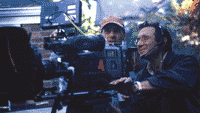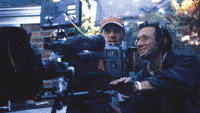Cine-style lenses for video cameras


DP Michael Mayers (left) uses 24p cameras to shoot the television series “The Education of Max Bickford.” Camera operator Peter Fernberger is shown using a Sony HDW F-900 camera configured with Angenieux lenses.
As camera technology improves, producers and directors have found increasing applicability of video cameras in what was formerly exclusive film territory. While there will always be situations where film is the better choice, the state-of-the-art in video cameras is exceedingly good and getting better.
As producers increasingly use video for their projects, lens makers have been challenged to build a set of solutions that more closely match the performance and operation of products that these users are familiar with. While video lenses are good products, film lenses have different demands and actually operate somewhat uniquely. Let’s look at some of the key challenges a producer may find as he moves into video.
The challenge to change
Clairmont Camera has been around long enough to know that if you are late embracing a new technology, you may lose valuable market share down the road. The trick is to learn all you can before you make the leap and be ready when the demand is there. Recently, after a long and assiduous review of camera and lens technologies, we began purchasing 24p high-definition equipment, including Panasonic and Sony 24p cameras and Fujinon HDTV cine style lenses.
Video camera manufacturers have been trying to gain a foothold in the film industry for at least a decade, but it was not until the introduction of the 24p format HDTV camera that they started seeing some success. The 24p format was developed in order to provide a video image that resembles a film picture in many respects, including the key aspect of 24fps operation.
Because a growing number of movies and TV shows are being produced in HD, equipment rental companies are now seeing an increase in demand for 24p equipment for both testing and actual production and testing. “Pasadena” and “Mysterious Ways,” two television series produced in Vancouver, are shooting in 24p, and there is growing interest among motion-picture producers to experiment with the benefits of digital video. The key is lower production/film-to-process costs.
Get the TV Tech Newsletter
The professional video industry's #1 source for news, trends and product and tech information. Sign up below.
Until recently, a major hurdle in the acceptance of video has been a lack of lenses that are designed to mimic the functions, settings and quality of the lenses that DPs, cinematographers and camera assistants — called lens pullers in the UK — have grown accustomed to in the film industry.
Lens breathing
Two lens operational characteristics that must be addressed when using video cameras in formerly film applications is that of breathing and ramping. Breathing refers to a lens’ tendency to make an image look bigger or smaller when its focal length is changed. In other words, when you focus on something that is 1.5 meters away and then refocus on something that is 6 meters away, the images change in size.
Lens’ breathing is unacceptable when shooting drama. The audience should never be made aware of the camera’s presence. Chances are that if you watch a documentary or news segment, you won’t be disturbed by the breathing of ENG-style lenses. When you shoot documentaries, especially nature programs, you want to be as close as possible to the desired image, for instance that tiger and cub. And if the camera zooms in, the audience normally is not disturbed by the awareness that a camera is capturing the wildlife action.
Panasonic’s AG-DVX100 3-CCD cinema camera supports cinema-style 480p/24fps, as well as 480p/30fps and 480i/60 image capture.
However, imagine you’re doing a dramatic shot of a man sitting in a large plaza. Maybe he’s in Paris at a sidewalk café, and he’s a spy. He’s watching someone off the in the distance. The camera is first focused on him, and then it changes focus to the person he is watching. The image size doesn’t change with the focus change. That’s important.
Film-style lenses have evolved to the point where any breathing is so minimal that you don’t notice it. But with ENG-style lenses, everything starts to move, which is disruptive to an audience that, until then, felt like an invisible observer of the action.
Lens ramping
The other issue when using video cameras outfitted with ENG-style lenses involves exposure ramping, opening the iris or increasing the gain or light sensitivity to compensate for darker environments. Zoom lenses are particularly sensitive to this feature. When you use a zoom lens, particularly one that has a wide angle, everything appears to be distant. At any specific focal length, a specific amount of light transits through that lens and strikes the film or CCD sensor. With most zoom lenses, the speed of that lens (the amount of light that transits through the lens) can change as you zoom through focal lengths. ENG-type lenses provide an automatic exposure control that causes either the iris to open wider or the gain circuit of the camera’s CCD sensors to increase their sensitivity as the zoom increases.
However, when shooting drama, you don’t want this to happen. Once a scene is properly set up, you don’t want the camera making decisions for you. As a director or cinematographer, you might want it dark and scary on that stalker hiding behind some trees. You might want to see a little bit of his outline. Then, as you zoom in, you don’t want the shot to suddenly become bright and high key.
Markings and pitch
There is another fundamental difference in film and video lenses, and it has nothing to do with optical performance, but with labeling. In video applications, the shooter simply focuses while looking through the lens. But that’s not the way dramatic films are shot. With film, the operator composes the picture while looking through the lens. Though he’s trying to watch the focus, that’s not his only job. The focus task is often handled by a separate person, called the camera assistant. It’s his job to actually focus the camera during the shot. However, because the assistant isn’t looking through the lens, he needs to judge the distance between the camera and the subject and then correctly refocus the lens as the shot changes solely based on the engraved numbers on the lens. This requires that the lens be accurately and well-marked in terms of distance.
Documentary and ENG guys don’t work that way. They just reach up and re-focus in the middle of a scene. And if you’re watching a program in which a tiger gives birth to its cubs, when you see the subject go out and then come back into focus, it may not bother you much. But it is very disruptive when you’re watching a dramatic show, because it reminds you that the camera is present.
Lens mechanics
Finally, most video lenses have developed first based on the need for quick shots. Getting the shot is more important than getting the perfect shot. Focus and zoom features must be easily accessible and fast. This has resulted in video lenses having a different gear pitch than film-style lenses. Neither approach is right or wrong; they are just different. Film producers are used to lenses feeling like and operating like, well, film lenses. This need has directed lens manufacturers to simulate operations and feel of film lenses, often called digi-cine lenses, for film-like, video applications. The result is video lenses that have the gears in the same place and the same pitch as film-style focusing devices.
As more productions move to video and 24p equipment drops in price, you will see an increasing demand for cine-like lenses. Whether or not this type of lens is well-suited for your application depends on a great many factors. One way to find out is to rent a lens and give it a try. You may find that “film” is the way to go, but on video.
Denny Clairmont is president of Clairmont Camera.
